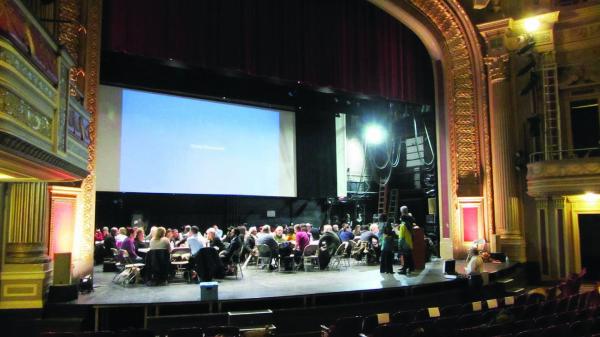December 20, 2018

Residents gathered for a planning session in the Strand Theatre last year.
City planners are distilling feedback from the most recent public meeting on the Uphams Corner implementation process, which seeks to transform a number of city - and land trust-owned parcels in the village’s core into an arts innovation district.
Some 90 people showed up at a Nov. 27 Boston Planning and Development Agency (BPDA) meeting to look at draft language for three Requests for Proposals (RFPs) that the city will send out as the initiative finishes up.
They cover parcels that contain two early 20th century bank buildings and neighboring parking lots, the century-old Strand Theatre, and a city municipal lot.
“There is still work to be done,” said Andrew Grace, the city’s director of strategic planning and economic development. In early January, the team said, they anticipate reconvening and working to incorporate the meeting feedback into new drafts.
A few months had passed since the last community meeting on the RFPs, which will set out guidelines for any developers looking to build and manage the new neighborhood spaces. The advisory group had met in the interim between the sessions.
Bob Haas, a civic leader and member of the Working Advisory Group, concurred with city officials that the November attendance was representative and encouraging. “The meeting had one of the largest and most diverse turnouts of any convened by the BPDA recently,” he wrote in an email.
Attendees broke into small groups focused on arts innovation, the Strand Theatre, economic and commercial development, housing, and other topics like parking and transportation, Haas said. They reviewed development guidelines that may make it into the final RFPs, spanning from the best uses of the sites to the characteristics of commercial units that might occupy them.
“The synthesis of information gathered, on sticky notes, is still in progress and will influence the final RFP language on development guidelines and evaluation criteria,” he wrote. “This has been a highly participatory, transparent process, which makes it difficult for me to describe outcomes until they emerge in written form.”
Some of the elements in the meeting materials include guidelines on proportions of units that must be set aside for low-income households — about one-third of both rental and homeownership options. About 20 percent of the units would be set aside for artists, also with affordability caps.
Nicole, a resident who asked to go only by her first name, said, “It is great to see ‘development without displacement’ in the RFP because it comes up all the time.”
In her email, she added, “My top concerns are affordability and the type of housing stock, support for small business (current and potential), arts/culture, and the library. I am excited about the new library and the potential for housing. I think by the city working with established organizations such as DSNI/DNI among others, it can help get community support and those organizations know the specific needs of the community.”
She also highlighted the need for green space in the area, which largely depends on small parks at the moment.
“Development without displacement is really the theme of the whole effort,” Haas explained, “with larger ratios of affordable housing than in other projects, plus commercial units targeted to rent levels accessible to entrepreneurs from the local community, some of whom would graduate from programs of the local Fairmount Innovation Lab. The challenge is to develop arts programs available as career avenues for local youth from lower income / immigrant families, and have these activities sustain over time, while their families can remain nearby.”
Other guidelines set out expectations for the best structure and operation of the forthcoming $18 million Uphams Corner Library, which attendees agreed should be in conversation with the arts district and Strand. Hybrid space and arts space should run through most of the project, according to the presentation materials.
Although affordability components are not as firm around commercial lots, the draft language included the needs for small footprints that fit many of the organic commercial needs of the village.
Attendees pressed the city’s economic development chief, John Barros, on how to ensure commitments to diversity and affordability would be met.
“There’s a lot of language in the RFP around making sure this is not just affordable and accessible, but that the folks who are participating in the finance and the actual businesses created, that there’s a lot of local community investment in those things,” said Kristina Ricco, senior planner with the BPDA, after the meeting.
“As to how the city’s going to make sure that happens,” she said, “as John Barros alluded to, our primary tool is that these are expected to be ground leases, so the city continues to own the property, which gives us more control than areas where the city is just selling a parcel for development.”
A question that still remains is how best to ensure community oversight in the new district. There may be an organization formed specifically to steward the arts and innovation district long-term, Ricco said.
“There’s a real possibility when something takes a full year that people fatigue and lose interest… but it doesn’t seem that that’s happened. People have been along with us for a long time and are looking forward to us releasing the RFP and getting on with the next step, and we’re making sure we’re very careful about crossing every ‘T’ and dotting every ‘I,’ because it’s a big project.”


